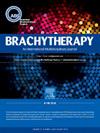有不良预后因素的T1-3N0M0期口腔癌术后单独高剂量近距离放疗:一项回顾性研究
IF 1.7
4区 医学
Q4 ONCOLOGY
引用次数: 0
摘要
目的:评价T1-3N0M0期口腔癌手术后高剂量率近距离放疗(HDR-BT)患者的治疗效果和毒性。方法和材料:回顾性研究50例T1-T3N0期舌口癌患者,由于存在不良预后因素(切缘闭合或阳性、淋巴血管和/或神经周围浸润、深部浸润),行肿瘤切除(+择期颈部清扫)并术后HDR-BT。采用塑料管技术(剂量:18 × 3gy b.i.d)。评估生存结果、毒性和预后因素。结果:中位随访81个月(范围4-121个月),精算5年局部控制率(LC)、淋巴结控制率(NC)和无进展生存率(PFS)分别为79%、69%和64%。经抢救治疗(手术 + 外束流放疗)后,LC、NC和PFS分别上升至87%、77%和72.3%。五年总生存率和癌症特异性生存率(CSS)分别为73%和77%。治疗相关毒性包括2例下颌骨放射性骨坏死和5例小软组织坏死。T分期与淋巴结控制(p=0.02)和CSS (p=0.04)显著相关。肿瘤分级与DFS相关(p=0.01)。结论:对于预后不良的T1-3N0M0口腔癌术后患者,术后HDR-BT 18 × 3gy b.i.d.可能是一种有效的治疗方法。本文章由计算机程序翻译,如有差异,请以英文原文为准。
Postoperative high-dose-rate brachytherapy alone in stage T1-3N0M0 oral cancer with negative prognostic factors: A retrospective study
Purpose
To evaluate treatment outcomes and toxicity in patients with stage T1-3N0M0 oral cancer treated with surgery followed by high-dose-rate brachytherapy (HDR-BT).
Methods and materials
Retrospective study of 50 patients with stage T1-T3N0 tongue and floor-of-mouth cancer who underwent tumour excision (+ elective neck dissection) followed by postoperative HDR-BT due to the presence of negative prognostic factors (close or positive resection margins, lymphovascular and/or perineural invasion, deep invasion). The plastic tube technique (dose: 18 x 3 Gy b.i.d.) was used. Survival outcomes, toxicity, and prognostic factors were evaluated.
Results
At a median follow-up of 81 months (range, 4-121), actuarial 5-year local control (LC), nodal control (NC) and progression-free survival (PFS) rates were 79%, 69%, and 64%. After salvage treatment (surgery + external beam radiotherapy), LC, NC, and PFS increased to 87%, 77%, and 72.3%, respectively. Five-year overall survival and cancer-specific survival (CSS) rates were 73% and 77%. Treatmentrelated toxicity included two cases of mandibular osteoradionecrosis and five cases of small soft tissue necrosis. T stage was significantly correlated with nodal control (p=0.02) and CSS (p=0.04). Tumour grade correlated with DFS (p=0.01).
Conclusion
Postoperative HDR-BT 18 x 3 Gy b.i.d. seems to be an effective method in patients with T1-3N0M0 oral cancer with negative prognostic factors after tumour resection.
求助全文
通过发布文献求助,成功后即可免费获取论文全文。
去求助
来源期刊

Brachytherapy
医学-核医学
CiteScore
3.40
自引率
21.10%
发文量
119
审稿时长
9.1 weeks
期刊介绍:
Brachytherapy is an international and multidisciplinary journal that publishes original peer-reviewed articles and selected reviews on the techniques and clinical applications of interstitial and intracavitary radiation in the management of cancers. Laboratory and experimental research relevant to clinical practice is also included. Related disciplines include medical physics, medical oncology, and radiation oncology and radiology. Brachytherapy publishes technical advances, original articles, reviews, and point/counterpoint on controversial issues. Original articles that address any aspect of brachytherapy are invited. Letters to the Editor-in-Chief are encouraged.
 求助内容:
求助内容: 应助结果提醒方式:
应助结果提醒方式:


